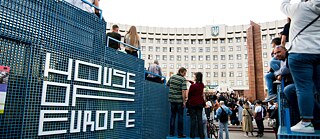”House of Europe“
Signs of Life

The EU programme “House of Europe” had become one of the most important funding organisations for Ukrainian culture and society. But after Russia’s invasion of Ukraine, it has had to reinvent itself.
By Christian Diemer
There is a before – and an after. Before 24 February 2022, the EU programme “House of Europe” was a (European) centre for dreams and ideas to be transformed into mutual learning experiences and cooperative projects. 139 calls for proposals received over 15,000 submissions, resulting in more than 4,500 successful applications: not only Ukrainian individuals and companies working in culture and creative fields, but also “agents of change” from the sectors of education, healthcare, media, social entrepreneurship, youth services – in short, from all of the country’s most critical areas of reform. Since 2019, they had worked with experts or partner organisations from almost every European country. They developed online courses to analyse environmental data, for example, or invented new choreography. They created ethnographic online presentations of queer biographies; formats to process totalitarian secret service experiences across international borders; opera co-productions; and much more.
From the perspective of the EU, the project – under the leadership of the Goethe-Institut – was intended to be a model of European cultural foreign policy in a strategically important neighbouring country to the EU, namely Ukraine. It was designed to be an immaterial home, a multidimensional space for encounters between people. To date, House of Europe is the largest cultural programme the EU has launched in a country outside its borders.
There is no better embodiment of the programme’s massive scope, extending all the way into the peripheries of Ukraine, than the Mobile Pavilion – “changeable” architecture developed by House of Europe and a team of young Ukrainian architects. Set up for several weeks each summer on public squares in Ukrainian provincial towns, the structure became part of the urban space for social interaction – and also a venue for cultural events and seminars. Only 25 percent of House of Europe’s funding went to institutions in Kyiv. Decentralised “Houses of Europe” opened their doors in cities of all sizes in the regions of Rivne, Dnipro, Mykolaiv, Kamianets-Podilskyi and Ivano-Frankivsk. On 17 February, the final peaceful Thursday before the outbreak of war, courageous partners kept the pop-up “House of Europe” open in Kharkiv as a temporary event and information room in the premises of Bahasch, the local marketing school.
Subsequent to 24 February, the House of Europe has been fighting for survival and immediate emergency aid. The majority of the House of Europe team is still living in Ukraine. Life-saving protective equipment and first aid has been paid for using some of the House of Europe’s budget. The pop-up hub in Kharkiv has been repurposed as a medical centre. “Humanitarian gear is now stored amongst translated books and info flyers funded by House of Europe. Our partners send us signs of life by email: ‘We’re alive and we’ll never let anyone take over our beautiful city.’” Funding recipients in Mariupol have used the most recently issued payment to evacuate members of their non-governmental organization from the besieged city. House of Europe is supporting its more than 900 alumni and alumnae with emergency grants. It is currently allocating money for the evacuation of precious art and cultural heritage from more than 30 museums, for the documentation of Russian war crimes and for the restoration of cultural institutions damaged by the war. More than 1.3 million euros have been deployed within a very short time as part of the crisis aid package.